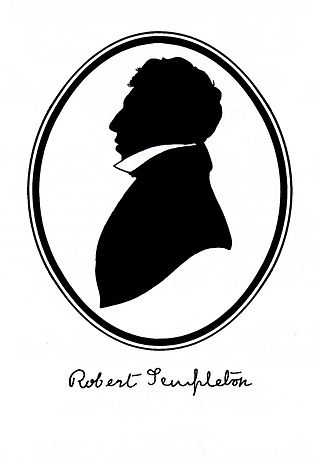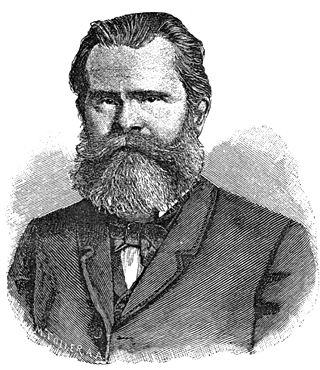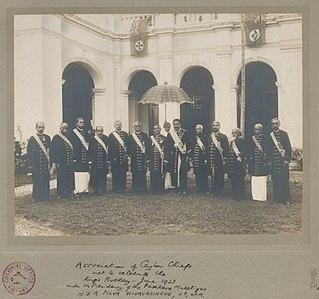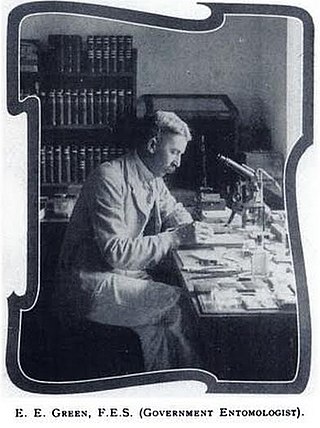
Ernst Gustav Kraatz was a German entomologist. He collected and described numerous beetles including Staphylinidae. Kraatz was a founding member of the Berlin Entomological Club and the German entomological society and the first editor of its journal, the Deutsche Entomologische Zeitschrift. Kraatz was involved in improving the standards of taxonomic description in German entomology and he was a proponent of a national collection that allowed public access to specimens.

John Clark Marshman was an English journalist and historian. He was editor and publisher of the Calcutta-based Friend of India, and was involved with several other Indian publications.

Francis Walker was an English entomologist. He was born in Southgate, London, on 31 July 1809 and died at Wanstead, England on 5 October 1874. He was one of the most prolific authors in entomology, and stirred controversy during his later life as his publications resulted in a huge number of junior synonyms. However, his assiduous work on the collections of the British Museum had great significance.

Robert Templeton was a naturalist, artist, and entomologist, and was born at Cranmore House, Belfast, Ireland.
William Stephen Atkinson was a British lepidopterist who worked for much of his life in India.

Otto Staudinger was a German entomologist and a natural history dealer considered one of the largest in the world specialising in the collection and sale of insects to museums, scientific institutions, and individuals.
Charles Lionel Augustus de Nicéville was a curator at the Indian Museum in Calcutta. He studied the butterflies of the Indian Subcontinent and wrote a three volume monograph on the butterflies of India, Bangladesh, Nepal, Burma and Sri Lanka. He also studied the mantids of the Oriental region.

Robert Wight was a Scottish surgeon in the East India Company, whose professional career was spent entirely in southern India, where his greatest achievements were in botany – as an economic botanist and leading taxonomist in south India. He contributed to the introduction of American cotton. As a taxonomist he described 110 new genera and 1267 new species of flowering plants. He employed Indian botanical artists to illustrate many plants collected by himself and Indian collectors he trained. Some of these illustrations were published by William Hooker in Britain, but from 1838 he published a series of illustrated works in Madras including the uncoloured, six-volume Icones Plantarum Indiae Orientalis (1838–53) and two hand-coloured, two-volume works, the Illustrations of Indian Botany (1838–50) and Spicilegium Neilgherrense (1845–51). By the time he retired from India in 1853 he had published 2464 illustrations of Indian plants. The standard author abbreviation Wight is used to indicate this person as the author when citing a botanical name.
Lieutenant Colonel Edward Frederick Kelaart was a Ceylonese-born physician and naturalist. He made some of the first systematic studies from the region and described many plants and animals from Sri Lanka.

Mudaliyar was a Ceylonese colonial title during Portuguese and British rule of the island. Stemming from the native headman system, the title was usually hereditary, made to wealthy influential families loyal to the British Crown.
Johann Jakob Bernhardi was a German doctor and botanist.

Edward Ernest Green was a Ceylon-born English mycologist and entomologist who specialised in the scale-insects, Coccidae. An accomplished artist, and lithographer, he illustrated the five volume Coccidae of Ceylon.

Johannes von Nepomuk Franz Xaver Gistel [Gistl] was a German naturalist. He worked at the Museum of Natural History in Regensburg, and wrote on a range of topics under the pseudonyms Garduus and G. Tilesius. His contributions to entomology include descriptions of species, with many new names he proposed now mostly relegated to synonymy.
William Henry Benson was a civil servant in British India and a pioneer malacologist. He made large collections of molluscs and described over 470 species, mainly from India, Sri Lanka, Burma and South Africa.

Wilhelm Dunker, full name Wilhelm Bernhard Rudolph Hadrian Dunker was a German geologist, paleontologist and zoologist.

George Wall was a merchant, coffee planter, politician, amateur astronomer, botanist and humanitarian in Ceylon.

St. Mark's Church, is an Anglican church in Badulla in Sri Lanka. The church is located in the central ward of Badulla Municipal Council at the junction of Mahiyangana – Badulla main road (B36). It was consecrated on 25 April 1857 by Bishop James Chapman. In April 2008 the church and the bell tower were formally recognised by the Government as an archaeological protected monument in Sri Lanka and declared as "protected monuments" by the acting Minister of National Heritage, Mahinda Yapa Abeywardena. The designation was formally included on 6 June 2008 in the government Gazette number 1553.
Johannes or John Waterstradt was a German-born Danish natural history collector and mineral prospector in Southeast Asia. He collected birds, orchids, butterflies and moths from the Papua New Guinea and Indonesian regions for several European collectors including Otto Staudinger and Hans Fruhstorfer. The mountain peacock pheasant Polyplectron inopinatum was named and described by Walter Rothschild from a specimen collected by him. He was a pioneer of commercial orchid cultivation and hybridization in Denmark.
Egbert Bletterman, was the first official Postmaster General of Ceylon, serving from 1815 to 1817.
Richard Hawksworth Barnes FLS (1831–1904) was a British meteorologist and naturalist, who spent time working as a coffee grower in Ceylon, where he collected specimens for the British Museum.













